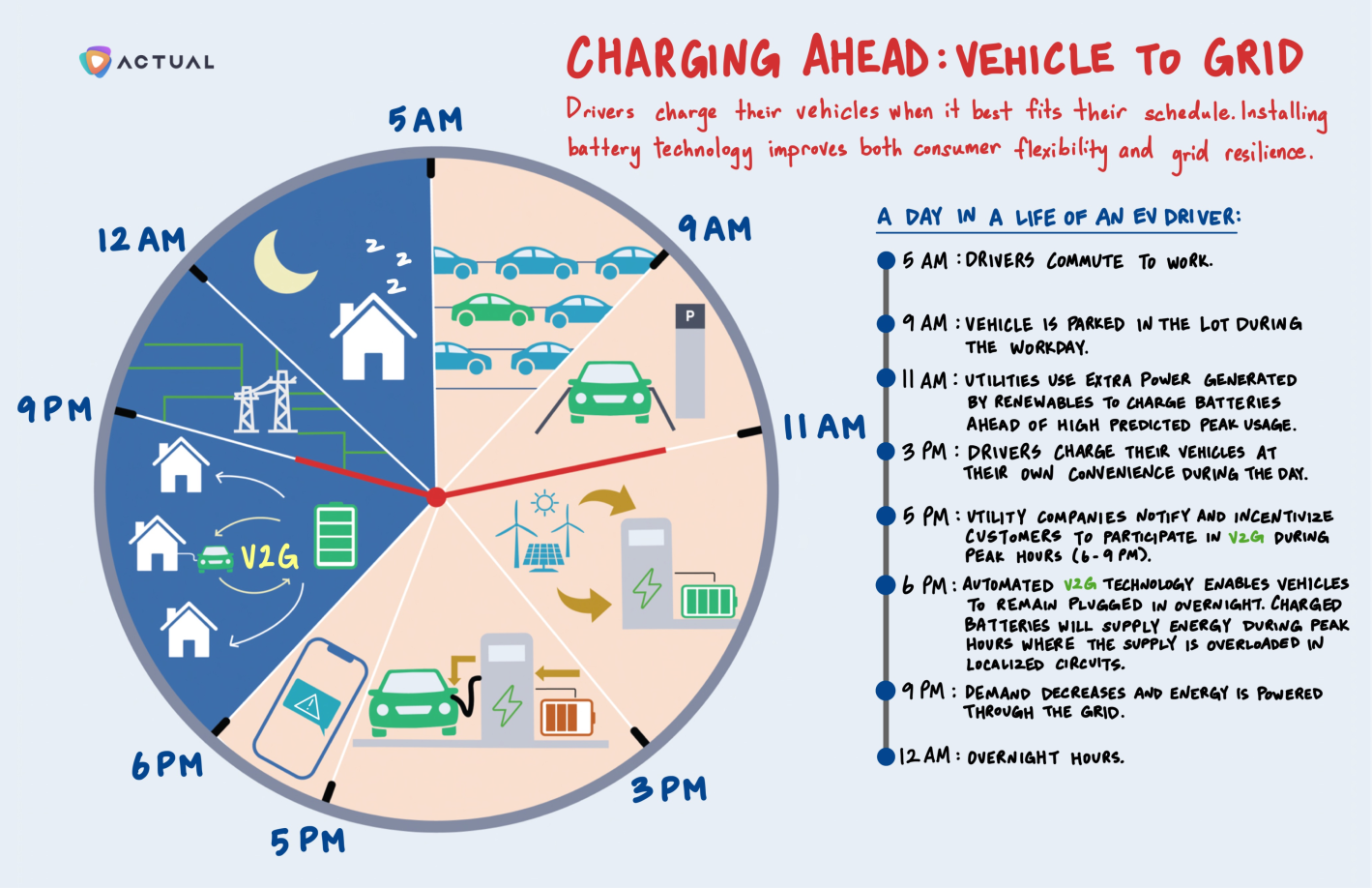
August 17, 2023
Charging Ahead: Vehicle to Grid
By 2030, green buildings with rooftop solar panels could be the new normal, EVs could dominate the roads, and the grid could be powered by renewable energy sources. But how do we get there? Utility companies anticipate that the load on the grid will increase by 70% over the next 20 years. In order to unlock the potential of vehicle-to-grid (V2G) power and make the grid more reliable, we need to invest in new battery storage infrastructure.
How does this affect you?
CFOs and capital planning teams need to find opportunities to invest in technology that will guarantee not only long-term returns, but that can also function as intermediate steps that accelerate the renewable energy transition.
Utilities planning teams need to analyze how centralized battery storage can optimize the full value of distributed energy resources (DERs) in localized circuits and decrease the amount of curtailed energy during the day.
Business and corporate development teams need to identify revenue streams and financial incentives that will encourage consumers to transition toward V2G.
EV charging companies and operators need to collaborate with utility companies to maximize ROI when charging stations are not at full capacity and find opportunities when energy would otherwise be wasted.

V2G infrastructure enables EV-owners to provide supplemental energy back to the grid during periods of peak demand. In California, it is anticipated that by 2035, the state will have sufficient storage capacity in EV batteries alone to power every home in the state for three days (70-80 kWh each). As utility companies build and retrofit existing infrastructure, installing battery storage at charging stations will further increase resilience in localized circuits.
Consumer behavior is one of the greatest challenges in scaling V2G infrastructure. The current incentive is simple: utility companies provide cheaper rates to charge during the day, with the goal of reducing the need to charge during peak evening hours. However, this is not a sufficiently strong incentive. EV-owners have been found to be less likely to change behavior driven by price differences alone and will prioritize convenience.
However, when prices are coupled with technology, there is a 10% improvement in demand during peak demand hours. For example, automated charging lets drivers conveniently plug in their cars while the charger switches between discharging and charging energy. In order to take advantage of these tools, utility companies will need to design a system that better suits the lives and behaviors of EV-owners. Installing battery storage at charging stations will do just this – it limits the reliance on the exact behavior of EV-owners while simultaneously providing additional capacity.
What are the benefits of battery storage at charging stations?
Flexibility. For V2G infrastructure to work effectively, vehicles need to be plugged in when demand is high. If batteries are installed at charging stations, the EV-owner can charge whenever and wherever is most convenient. Utility companies will not have to worry about opt-in or opt-out behaviors because batteries can charge over time and serve multiple customers.
Predict demand ahead of time. Batteries at these facilities need to be able to store energy preemptively and in anticipation of predictable future high demand.
Localized circuits. Utility companies will be able to track the amount of kWh available, and at any time, pull power out of the battery. Since energy will be distributed locally, utilities will not have to worry about long-distance transmission.
Time Shifting. Batteries located at charging stations would act as an intermediate step towards making V2G a more tractable solution by providing additional capacity to the grid during peak hours.
Location. Cars are plugged into chargers throughout the day, especially in many workplace buildings with public charging stations. Since most charging units are not at full capacity, energy available to power charging stations can be stored in batteries to use later in the day.
The Department of Energy estimates that the US needs to invest $330B in long duration energy storage by 2060. Installing smaller battery units is a less daunting task that also reduces demand on the grid. A standalone battery unit (minimum of 5 kWh) can receive up to 6% in investment tax credits through the IRA and can claim up to an additional 10% in investment or production tax credits if domestic content requirements are met.
Moving forward, it is key that systems do not act independently from one another, but as a whole. Utility companies need to better understand energy consumption patterns and consumer behaviors to effectively uphold a reliable grid, working in tandem with partners like charging companies. The power grid is going to look different in the next 20 years, and we need to be ready and adapt to change.
Until next time,
Actual
More recent newsletters
April 25, 2024
ACTUAL
Catalonia, Spain, has recently declared a drought emergency as reservoirs plunge to critically low levels at just 15% of full...
April 11, 2024
ACTUAL
The automotive industry has been undergoing a drastic transformation, transitioning from combustion engine vehicles to include EVs, hybrid engines, and...
March 21, 2024
ACTUAL
The thrilling races of Formula 1 are powered by behind-the-scenes innovation, where even the slightest tweaks in aerodynamics or engine...


